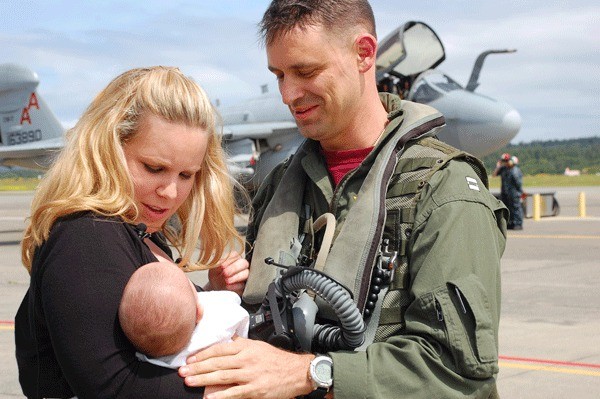In a folding metal chair within an enormous aircraft hangar on Whidbey Island Naval Air Station, 30-year-old Janice Fatora shifts nervously in her seat.
Sitting beside her is her mother-in-law and seven-week old son, Brendan. Fatora is nervous because in just a few minutes, Brendan will meet his father for the very first time. While there is little doubt it will become a cherished memory, she can’t help but feel a little apprehensive.
“When my husband left, I was barely showing,” she said. “Now he comes back and I have a baby. It’s a little scary.”
Her husband, Navy Lt. Charles Fatora, call sign “Blue,” has been on deployment with the rest of Electronic Attack Squadron VAQ-134 for the past seven months. The EA-6B Prowler squadron, consisting of 180 officers and support personnel, returned home Tuesday and Wednesday.
As this was the first carrier-based deployment the squadron undertook in 16 years, it was a long seven months and Charles Fatora was overjoyed to see his son. Getting in his first look on the tarmac, he struggled to find the right words.
“Awesome; indescribable really,” he said. “Surreal is a good word.”
The squadron, also known as the Garudas, is one of 12 that call NAS Whidbey Island home. While they are one of the few land-based expeditionary squadrons, this particular deployment called them to serve aboard the USS Carl Vinson.
This past May, the ship became the subject of headlines across the world when, from its decks, international terrorist Osama bin Laden was buried at sea.
However, it appears that will have to be a story saved for the grandkids as Kimberly Martin, the base’s public information officer, said the squadron had nothing to do with the event and personnel were instructed not to comment.
However, being on the same ship that bin Laden was buried from isn’t the Garudas’ only claim to fame for this deployment. The squadron flew combat missions in Operation Enduring Freedom over the skies of Afghanistan and Operation New Dawn over Iraq.
VAQ-134 also set a new bar of excellence with a 47 percent increase in electronic attack coverage, compared with previous air wings, while maintaining a 96 percent combat sortie completion rate. In all, it conducted 156 missions.
Tuesday’s fly in welcomed home mainly VAQ-134’s officers. The rest of the squadron, composed largely of the enlisted sailors who work to support and maintain its four Prowlers, are expected to arrive today.
While aircrews tend to get the spotlight, their performance is contingent on the hard work of the squadron’s maintenance and operations personnel. Without them, the Garudas would never have been able to accomplish so much, squadron Commanding Officer Cmdr. Lee Jackson said.
“That’s all the maintenance guys,” he said. “They made it happen.”



